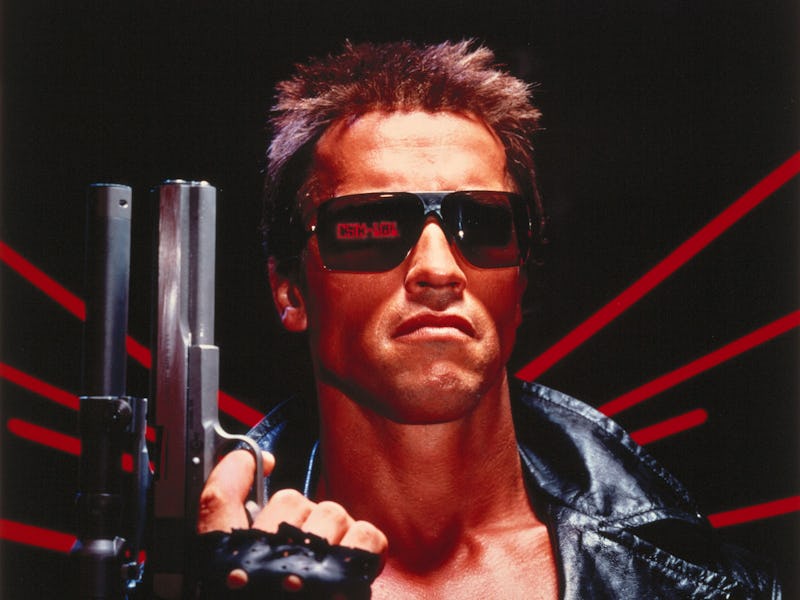James Cameron’s Iconic Sci-Fi Thriller Set the Standard for Action Exposition
Forty years later, The Terminator is still the gold standard for exposition dumps.

“Come with me if you want to live.” These words, spoken by a sweaty, bug-eyed Kyle Reese (Michael Biehn) after temporarily blowing away Arnold Schwarzenegger’s cybernetic assassin from the future, are now recognized as pure pulp cinema poetry. After pointing its three main characters — the T-800 “Terminator,” out-of-time resistance fighter Kyle Reese, and Sarah Connor (Linda Hamilton), the mother to humanity’s future savior — on an inevitable, dread-inducing collision course for the entire first act, Kyle’s first words to Sarah propel the film into its deadlocked, streamlined chase. Her world is falling apart in real time, and this is the only man who wants to stop that from happening.
The titanic space that James Cameron takes up in popular culture belies just how economic his storytelling instincts are. The Terminator, which celebrates its 40th anniversary with a 4K restoration on Blu-ray (plus a theatrical re-release earlier in the year), isn’t just a debut thriller that’s as lo-fi as it is white-knuckle; it’s the blueprint for everything he wrote afterward. We are guided through sci-fi worlds with immediate emotion, escalating action, and a palpable sense that the clock is ticking to figure out what’s going on. Exposition dumps aren’t exactly what eager superfans will pore over 4K restorations for, but Cameron’s remastered vision of hell leaking backward in time really emphasizes the urgency of making a Denny’s waiter believe she’s the most important woman alive — and why she has to stay that way.
Michael Biehn has a tricky job, delivering exposition while shouldering the movie’s action beats.
When Sarah Connor escapes from the Tech Noir bar with Kyle, crossing the threshold into a fight that will define the rest of her life, The Terminator now needs to speed-run through backstory/future-story. As the T-800 returns from the brink of death to pursue them across Los Angeles, Sarah’s protector catches her up on what hasn’t happened yet: the future war with Skynet, her unborn son being the cyberpunk messiah, and the history and function of Terminators, the machines using time travel as a last resort to cheat a victory. Sweat glistens off his face; his eyes bore into Sarah’s incredulous face. It’s the first time Kyle pushes all his intensity onto Sarah — he delivered his iconic opening line with his eyes trained on the down-but-not-out cyborg lying on the Tech Noir sidewalk.
“Pay attention!” Kyle barks when Sarah interrupts his monologue, weaving their stolen car through a parking garage. His exposition dump is smuggled in between two major, sensory-overloading action scenes, but the sense of danger never dissipates. We’re forced to focus on multiple things at once — there’s the immediate, physical threat of being pulverized by a cyborg and a broader existential threat of what he means for the future of Earth. Biehn’s delivery has become the unofficial gold standard for action exposition — a bare-teethed, almost-pleading insistence that millions depend on you to fight for your life, even if it’s difficult to tangibly understand why.
It’s worth noting that Biehn has to sell the war-torn future in his performance because Cameron could not afford to show it for more than a couple minutes total — the film was so low-budget that a dingy, unpopulated parking lot was the only place this necessary information could be communicated. It works because, until this scene, nearly all of these details have been deliberately kept at arm’s length for maximum dramatic impact but also because The Terminator works absolutely fine for 30 minutes with little to no exposition. The T-800’s machine vision; Reese’s furtive desperation compared to the brutal, decisive momentum of his adversary; his exhausted dream of life on the resistance frontline — these details play to Cameron’s strengths as a visual, dramatic storyteller. Even when he does a dialogue-only scene, those instincts come in clutch — action exposition has rarely felt this charged and stressful.
The Terminator wasn’t the first genre film to perfect its otherworldly exposition dump, but its dramatic economy and intensity have been imitated through the four decades since its release. In Speed, Dennis Hopper’s maniacal villain gloats over the details of his bomb-rigged bus to Keanu Reeves just as the bus turns onto his street, the overriding sense of being taunted hanging over our hero’s breathless journey. The Mission: Impossible films feature so many high-concept setpieces relying on timing that the exposition explaining how Ethan should risk his life is often charged with uncertainty. Fast-paced blockbusters like these are also the bread and butter of J.J. Abrams, whose Star Trek and Star Wars films refuse to slow down the action for contextual dialogue, so all the exposition feels like it’s trying to keep pace with the constant movement. The most obvious successor to Cameron’s effusive excitement for his Terminator world-building is likely Christopher Nolan, whose dream-heist thriller Inception depends on an exposition machine that is nearly constantly doling out information.
But not being blessed with a super-sized production budget (yet), Cameron was faced with bare-bones resources and an ethos of dramatic precision and necessity. The result was a film that got us from one action sequence to another, but also laid down the fundamental rules for expositing in the heat of the battle.